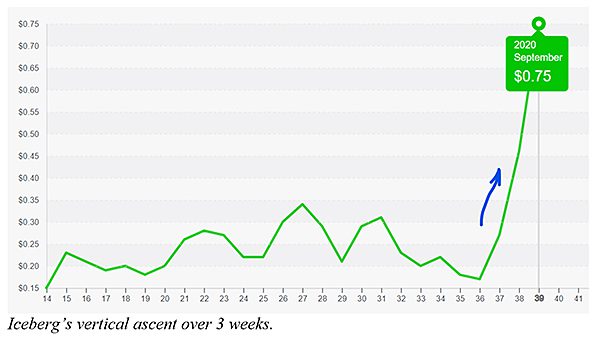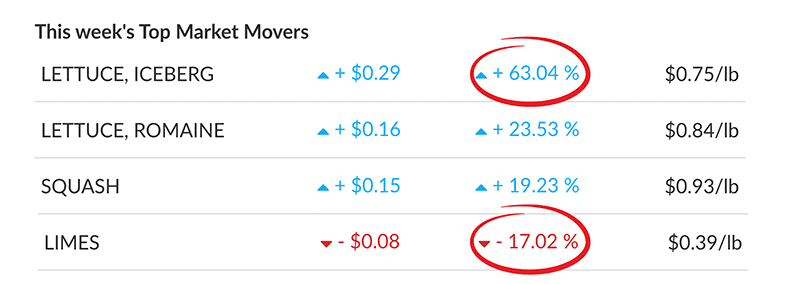
Poor weather conditions in growing regions are sending iceberg lettuce prices on an even steeper incline.
ProduceIQ Index: $0.85 /pound, +6.3 percent over prior week
Iceberg leapt off its floor price, from $0.17 to 0.75 over a three-week period. Spiking 340% in such a short time only happens when supply declines dramatically. Variations in supply, much more so than demand, is what drives price in our industry. Iceberg is impacted by a list of defects, and some soil diseases (sclerotinia), induced by the extreme California heat during this growing season. Even higher prices are anticipated for the Lettuce & Leaf category over the next few weeks as another heat wave threatens California.
Limes have fallen off their peak, easing from $0.70 to $0.39 over the past 7 weeks, as more supply is anticipated from Mexico. Watch for prices to fall further and buy higher count, 230-250ct, for better value.
Squash prices are high, $0.93 /pound, for this time of year. The historical pattern is for Squash prices to descend for the next 6 weeks until November’s Thanksgiving pull. Prices are generally volatile for this “short” crop (fewer grow days). This crop is impacted by rain in the Eastern growing regions, namely Southern Georgia. Western growing regions are experiencing temperature extremes, which impact the quality on this sensitive commodity.
 At $0.91, Grapes are one of the few commodities that are in good supply. Grapes remain promotable for the next 5 weeks and are seasonally stable.
At $0.91, Grapes are one of the few commodities that are in good supply. Grapes remain promotable for the next 5 weeks and are seasonally stable.
At $0.93 /pound, Squash prices are high though facing a seasonal valley over the next 6 weeks.

ProduceIQ Index
 The ProduceIQ Index is the fresh produce industry’s only shipping point price index. It represents the industry-wide price per pound at the location of packing for domestic produce, and at the port of U.S. entry for imported produce.
The ProduceIQ Index is the fresh produce industry’s only shipping point price index. It represents the industry-wide price per pound at the location of packing for domestic produce, and at the port of U.S. entry for imported produce.
ProduceIQ uses 40 top commodities to represent the industry. The Index weights each commodity dynamically, by season, as a function of the weekly 5-year rolling average Sales. Sales are calculated using the USDA’s Agricultural Marketing Service for movement and price data. The Index serves as a fair benchmark for industry price performance.
Poor weather conditions in growing regions are sending iceberg lettuce prices on an even steeper incline.
ProduceIQ Index: $0.85 /pound, +6.3 percent over prior week
Iceberg leapt off its floor price, from $0.17 to 0.75 over a three-week period. Spiking 340% in such a short time only happens when supply declines dramatically. Variations in supply, much more so than demand, is what drives price in our industry. Iceberg is impacted by a list of defects, and some soil diseases (sclerotinia), induced by the extreme California heat during this growing season. Even higher prices are anticipated for the Lettuce & Leaf category over the next few weeks as another heat wave threatens California.
Limes have fallen off their peak, easing from $0.70 to $0.39 over the past 7 weeks, as more supply is anticipated from Mexico. Watch for prices to fall further and buy higher count, 230-250ct, for better value.
Squash prices are high, $0.93 /pound, for this time of year. The historical pattern is for Squash prices to descend for the next 6 weeks until November’s Thanksgiving pull. Prices are generally volatile for this “short” crop (fewer grow days). This crop is impacted by rain in the Eastern growing regions, namely Southern Georgia. Western growing regions are experiencing temperature extremes, which impact the quality on this sensitive commodity.
 At $0.91, Grapes are one of the few commodities that are in good supply. Grapes remain promotable for the next 5 weeks and are seasonally stable.
At $0.91, Grapes are one of the few commodities that are in good supply. Grapes remain promotable for the next 5 weeks and are seasonally stable.
At $0.93 /pound, Squash prices are high though facing a seasonal valley over the next 6 weeks.

ProduceIQ Index
 The ProduceIQ Index is the fresh produce industry’s only shipping point price index. It represents the industry-wide price per pound at the location of packing for domestic produce, and at the port of U.S. entry for imported produce.
The ProduceIQ Index is the fresh produce industry’s only shipping point price index. It represents the industry-wide price per pound at the location of packing for domestic produce, and at the port of U.S. entry for imported produce.
ProduceIQ uses 40 top commodities to represent the industry. The Index weights each commodity dynamically, by season, as a function of the weekly 5-year rolling average Sales. Sales are calculated using the USDA’s Agricultural Marketing Service for movement and price data. The Index serves as a fair benchmark for industry price performance.
Mark Campbell was introduced to the fresh produce industry as a lender for Farm Credit. After earning his MBA from Columbia Business School, he spent seven years as CFO for J&J Family of Farms and later served as CFO advisor to several produce growers, shippers and distributors. In this role, Mark saw the impediments that prevent produce growers and buyers to trade with greater access and efficiency. This led him to cofound ProduceIQ.
 At $0.91, Grapes are one of the few commodities that are in good supply. Grapes remain promotable for the next 5 weeks and are seasonally stable.
At $0.91, Grapes are one of the few commodities that are in good supply. Grapes remain promotable for the next 5 weeks and are seasonally stable. The ProduceIQ Index is the fresh produce industry’s only shipping point price index. It represents the industry-wide price per pound at the location of packing for domestic produce, and at the port of U.S. entry for imported produce.
The ProduceIQ Index is the fresh produce industry’s only shipping point price index. It represents the industry-wide price per pound at the location of packing for domestic produce, and at the port of U.S. entry for imported produce.



